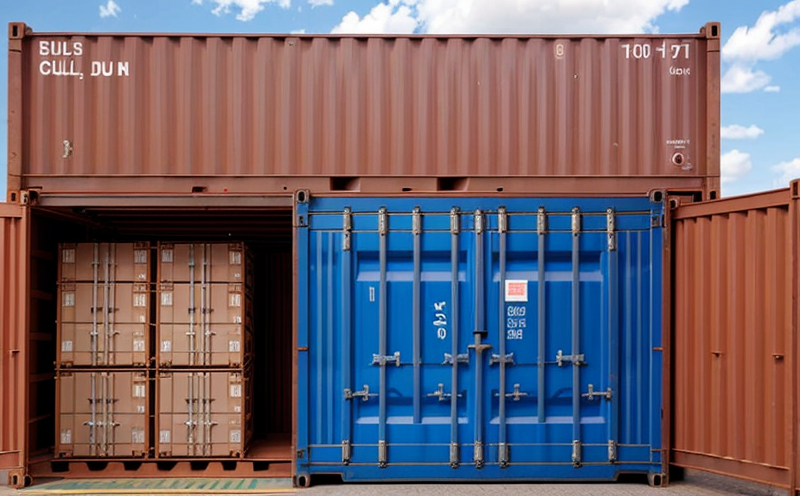USP Bubble Emission Integrity Testing
The USP Bubble Emission Integrity Test is a critical procedure used to evaluate the integrity of container closure systems (CCS) in pharmaceutical packaging. This test ensures that the CCS maintains its seal, preventing contamination and preserving the quality of the drug product during storage and distribution.
This test is particularly important for ensuring that the package design and manufacturing processes meet regulatory requirements set forth by the United States Pharmacopeia (USP). The USP specifies stringent criteria to ensure the safety and efficacy of pharmaceutical products. This integrity test checks for any potential leaks or breaches in the CCS, which could lead to contamination or loss of product integrity.
The procedure involves filling the container with a gas mixture under pressure, typically air and nitrogen, and then sealing it. The sealed container is then immersed in water at a specified temperature, usually 37°C (98.6°F), for a set period. During this time, any bubbles escaping from the container closure are counted and measured to determine if there is an issue with the CCS.
The test results are critical for pharmaceutical companies as they ensure that the packaging meets USP standards. Compliance with these standards helps to prevent recalls and ensures product quality, thereby protecting public health.
For accurate testing, it is crucial to follow strict protocols in specimen preparation, such as ensuring that the container is free from contaminants before testing. The test apparatus must also be calibrated correctly for precise results. Understanding the real-world implications of this test helps ensure that pharmaceutical products meet regulatory standards and are safe for consumers.
The USP Bubble Emission Integrity Test plays a vital role in maintaining the integrity of pharmaceutical packaging, ensuring product safety and efficacy. By adhering to these rigorous testing procedures, pharmaceutical companies can provide high-quality, reliable products that comply with international standards.
Scope and Methodology
| Parameter | Description |
|---|---|
| Test Specimen | The container closure system (CCS) to be tested. |
| Gas Mixture | A mixture of air and nitrogen, typically 1:4 ratio. |
| Immersion Temperature | 37°C ± 0.5°C (98.6°F ± 0.9°F). |
| Immersion Time | 2 hours minimum. |
| Bubble Counting | The number of bubbles escaping from the CCS is counted and measured. |
This table outlines the key parameters involved in conducting a USP Bubble Emission Integrity Test. The specimen must be prepared carefully, ensuring that it is free from contaminants before testing. The gas mixture used should be accurate to ensure reliable results. The immersion temperature and time are critical for obtaining consistent test results.
The test apparatus used includes a container to hold the CCS under pressure, a water bath at 37°C ± 0.5°C (98.6°F ± 0.9°F), and equipment to count bubbles escaping from the CCS. The apparatus must be calibrated correctly for accurate measurement of bubble emissions.
The test procedure involves filling the container with the gas mixture under pressure, sealing it, and then immersing it in water at the specified temperature. During this time, any bubbles escaping from the CCS are counted and measured. The results provide a measure of the integrity of the CCS, indicating whether there is any leakage or breach.
The testing process is essential for ensuring that the CCS meets USP standards and maintains product quality. By adhering to these rigorous protocols, pharmaceutical companies can ensure their products meet regulatory requirements and are safe for consumers.
Why Choose This Test
Selecting the USP Bubble Emission Integrity Test is crucial for several reasons. First, it ensures that the container closure system (CCS) remains intact during storage and distribution, preventing contamination of the pharmaceutical product. This test is particularly important in ensuring compliance with international standards such as USP.
The USP specifies stringent criteria to ensure the safety and efficacy of pharmaceutical products. By choosing this test, pharmaceutical companies can demonstrate their commitment to quality control and regulatory compliance. This, in turn, enhances consumer confidence in the product's integrity and safety.
Furthermore, selecting this test allows for early identification of potential issues with the CCS. Early detection enables corrective actions to be taken promptly, minimizing the risk of product contamination or loss of efficacy. This proactive approach helps pharmaceutical companies maintain high standards of quality assurance.
The results of the USP Bubble Emission Integrity Test are critical for ensuring that the packaging meets regulatory requirements and maintains product integrity. Compliance with these standards helps prevent recalls and ensures product quality, thereby protecting public health.
Choosing this test also provides peace of mind to pharmaceutical companies by reducing the risk of product failure or contamination. By adhering to rigorous testing procedures, companies can ensure their products meet international standards and are safe for consumers.
International Acceptance and Recognition
The USP Bubble Emission Integrity Test is widely recognized and accepted in the pharmaceutical industry. It is a key component of ensuring that container closure systems (CCS) meet stringent quality standards set by international regulatory bodies.
This test is particularly important for ensuring compliance with USP standards, which are recognized worldwide as benchmarks for pharmaceutical quality. By adhering to these rigorous testing procedures, pharmaceutical companies can ensure their products meet international standards and are safe for consumers.
The USP Bubble Emission Integrity Test has been adopted by various countries and regulatory agencies around the world. For instance, it is accepted by the European Medicines Agency (EMA) and the World Health Organization (WHO). This widespread acceptance ensures that pharmaceutical companies can confidently use this test in their quality assurance programs.
The recognition of this test extends beyond just pharmaceuticals to other industries such as food and beverage, where container integrity is equally important. By adhering to international standards like USP, these industries can ensure consistent product quality and safety.
Selecting the USP Bubble Emission Integrity Test demonstrates a commitment to quality and regulatory compliance. This proactive approach helps pharmaceutical companies maintain high standards of quality assurance and ensures that their products are safe for consumers worldwide.





